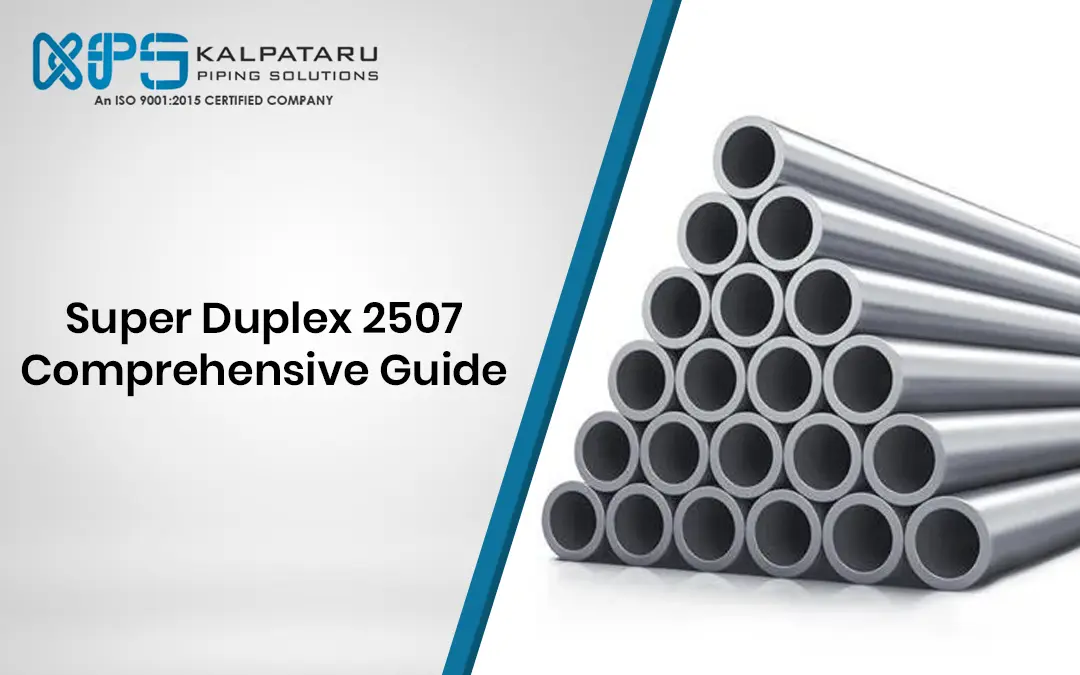High-performance stainless steel alloy Super Duplex 2507 (UNS S32750) has exceptional strength and resistance to corrosion. It is mostly used in elevated temperatures and extreme environments, such as those found in oil and gas exploration, chemical processing, and marine industries.
In this guide, we will explore the benefits of Duplex 2507 in industrial settings, as well as its chemical makeup, salient characteristics, and applications.
Super Duplex 2507 Overview
Super Duplex 2507, also known as Duplex 2507 or UNS S32750, is a high-strength duplex stainless steel 2507 alloy designed for harsh environments. With a composition of 25% chromium, 4% molybdenum, and 7% nickel, it provides exceptional resistance to stress corrosion cracking, crevice corrosion, and chloride pitting.
With a balanced austenite-ferrite microstructure (50/50), super duplex UNS S32750 offers exceptional mechanical strength and endurance due to its balanced austenite-ferrite microstructure (50/50). Because of its great strength, thinner materials may be used, which lowers weight and fabrication costs without compromising structural integrity.
Super Duplex 2507 Forms
Kalapataru Piping Solutions is a Leading manufacturer, supplier, and exporter of premium Super Duplex 2507 (UNS S32750) products. It is renowned for its exceptional strength, corrosion resistance, and resilience in harsh conditions.
Our Super Duplex S32750 Products
- Super Duplex Steel UNS S32750 Fasteners
- Super Duplex Steel UNS S32750 Seamless Pipes & Tubes
- Super Duplex Steel UNS S32750 Wire Mesh
- Super Duplex Steel UNS S32750 Plates & Sheets
- Super Duplex Steel UNS S32750 Filler Wire
- Super Duplex Steel UNS S32750 Buttweld Pipe Fittings
- Super Duplex Steel UNS S32750 Round Bars
Features of Super Duplex 2507 (UNS S32750)
2507 Chemical Composition
The chemical composition of Super Duplex 2507 is designed to provide exceptional corrosion resistance and high strength. About 25% of it is chromium, 4% is molybdenum, and 7% is nickel. Compared to common stainless steels like 304 or 316L, S32750 has a much higher resistance to localized corrosion due to its composition, which results in an outstanding pitting resistance equivalent number (PREN) of 42–45.
Mechanical Properties of Duplex 2507
Standard austenitic stainless steels have a yield strength of about 250 MPa, but S32750 typically has a yield strength of about 550 MPa. Because of its increased strength, thinner sections can be used without compromising structural integrity, which lowers equipment weight and overall material costs. Furthermore, even in high-stress situations, Duplex 2507 retains its mechanical qualities and exhibits exceptional wear resistance.
Corrosion Resistance of UNS S32750
UNS S32750 exhibits remarkable corrosion resistance, especially in harsh conditions with seawater, acids, and chlorides. It is perfect for the chemical processing, offshore, and maritime industries because of its high chromium, molybdenum, and nitrogen content, which improves its resistance to pitting and corrosion. Compared to austenitic stainless steels like 316L, which normally have a critical pitting temperature (CPT) below 30°C, Super Duplex 2507 has a CPT above 50°C.
Welding Considerations for Duplex 2507
Strict temperature control and the use of suitable filler materials are necessary while welding Super Duplex 2507 in order to preserve its dual-phase microstructure. Common methods for guaranteeing excellent welds include gas tungsten arc welding (GTAW), gas metal arc welding (GMAW), and shielded metal arc welding (SMAW). To avoid the production of unwanted intermetallic phases that can lower toughness and corrosion resistance, the interpass temperature must be carefully regulated to not exceed 150°C (300°F). Weld integrity and lifespan are guaranteed by appropriate post-weld inspection techniques like dye penetrant and ultrasonic testing.
Applications of Super Duplex 2507
Super Duplex 2507 stainless steel is perfect for industries that need to be strong and resistant to corrosion. Because of its resilience in challenging conditions, it finds extensive application in chemical processing, offshore oil and gas, and desalination facilities. The steel is necessary for PVC processing, industrial reactors, bleaching apparatus, and maritime applications such as ship shafts and propellers. Additionally, it is essential to fluid handling pipelines, exhaust scrubbers, and flue gas desulfurization (FGD) systems, guaranteeing sustained performance under demanding circumstances.
FAQs
What is Super Duplex 2507 ?
With 25% chromium, 4% molybdenum, and 7% nickel, Duplex 2507 (UNS S32750) is a high-performance stainless steel that exhibits exceptional strength and resistance to corrosion. It is frequently employed in petrochemical, marine, and chemical processing applications.
What distinguishes Duplex 2205 from Duplex 2507?
Duplex 2507 is less elongated than Duplex 2205, but it has greater yield strength, tensile strength, and impact toughness. Duplex 2205 provides a well-balanced mix of toughness, ductility, hardness, and strength.
What is equivalent to super duplex 2507?
ASTM A890, ASTM A995, and ASME SA351/995 grade CE3Mn or 5A are all identical to UNS S32750, commonly referred to as SAF 2507. It comes in a variety of shapes and sizes, including bars, plates, fittings, pipes, forgings, and castings.
Does Duplex 2507 Stainless Steel Rust?
Duplex 2507 stainless steel’s high chromium and molybdenum content makes it extremely resistant to rust. However, corrosion can develop over time in hostile environments, such as seawater or extended exposure to harsh chemicals. Maintaining it properly contributes to its longevity.




